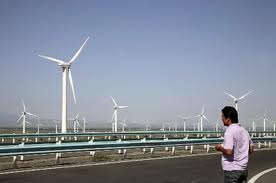China's green revolution to keep growing: IEA
 China will install wind and solar power capacity equivalent to 180 nuclear power reactors in the next 10 years to meet its growing energy needs, according to the International Energy Agency.
China will install wind and solar power capacity equivalent to 180 nuclear power reactors in the next 10 years to meet its growing energy needs, according to the International Energy Agency.Fatih Birol, chief economist at the IEA said that one in two of all hybrid cars or cars powered with natural gas or electricity will be sold in China in the next 20 years, even without a binding climate agreement.
China will install 180 gigawatts (GW) of wind and solar power capacity by 2020, equal to the capacity built by the rest of the world over the past 40 years.
China, which will account for one third of global energy demand growth between 2009 and 2035, currently has a wind power capacity of 42 GW and a solar power capacity of 1 GW.
The Paris-based IEA, which advises industrialized nations on energy issues, expects China’s electricity demand to grow by a yearly average of 4 percent to reach 9,000 terawatt hours by 2035. This is 18 times the consumption of a country like France and a tripling of China’s 2009 consumption levels.
“It will significantly bring down the cost of wind turbines and PV solar modules,” Birol said. “This is good news for China and the rest of the world.”
The IEA however expects China’s renewable energy capacity in its energy mix to remain below Latin America’s, the European Union’s, India’s and the United States’ by 2035, it said in its 2011 World Energy Outlook (WEO).
From consuming half as much energy as the United States in 2000, China is now the world’s biggest energy consumer, and is projected to use nearly 70% more than the United States in 2035, the IEA said in its WEO.
“The United States and China are responsible for almost half of the world’s CO2 emissions but I don’t see an appetite in those countries and others to make a legally binding agreement,” he said.
China with its population of 1.3 billion is the world’s biggest energy consumer and on track to become the world’s biggest oil importer by 2035, Birol said.
This is a major shift as the United States, which has dealt with oil security in the international arena for decades, will see its oil imports halve to 6 million barrels per day (mbpd) by 2035 as it boosts its oil output and increases car efficiency, Birol said.
 “Up to now the United States was the country which kept an eye on the international oil security at home and beyond its borders,” Birol said. “Oil security was never a major issue for Europe but it is coming.”
“Up to now the United States was the country which kept an eye on the international oil security at home and beyond its borders,” Birol said. “Oil security was never a major issue for Europe but it is coming.”Europe and China were next in line to play a key role in defending oil supply security and will be more vulnerable to oil prices and supply disruptions. European oil imports, which amount to 9 mbpd will overtake the U.S. by 2015 before being overtaken by China in 2020, whose oil imports are expected to reach 13 mbpd by 2035.
“There will be a new world map, this is a major change and we all need to prepare ourselves for it,” Birol said.
You can return to the main Market News page, or press the Back button on your browser.

